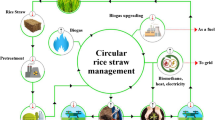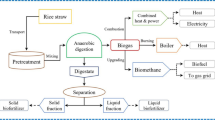Abstract
The challenges of climate change, energy security, ever-increasing price of fossil fuels in the international market, and the detrimental effects of its uses on the environment have prompted the scientific community toward environment-friendly, sustainable, and comparable alternative sources of energy. More than a hundred million tons of rice straws are produced annually as a byproduct in India, around 60% of which are burned in situ. Rice straw is a potential feedstock for second-generation biofuel production. Biofuel generated from this biowaste can benefit the world in numerous ways. It can reduce the import bill of coal and petroleum fuels, enhance farmers’ income, prevent straw burning incidences, and reduce greenhouse gas emissions, thereby making the environment clean. The characterization of biomass is a prerequisite to assessing its fitness for specific conversion technology for biofuel generation. In the present study, rice straws of two prominent varieties of paddy, namely Swarna and Silky-277 grown in Asian countries, were characterized, and their biomethane yield was compared to assess the feasibility as a biofuel feedstock and to find the role of each component of rice straw vis-à-vis biomethane yield. Apart from proximate and ultimate analysis, non-structural components (extractives) and structural components like cellulose, hemicelluloses, and lignin were also estimated by using standard protocols. The proximate and ultimate analysis differed marginally, structural components, cellulose, and hemicelluloses were found higher in Swarna, whereas lignin and non-structural components are found higher in the Silky-277 variety of rice straw. Out of several components present in rice straw, the role of non-structural components is found to be most important for biomethane yield. The presence of 46% higher non-structural components (extractives) in the Silky-277 variety resulted in a 21% higher biomethane yield than from the Swarna variety of rice straw. These findings will provide techno-economical liberty in selecting suitable rice straws to be used for anaerobic digestion at the commercial level.
Graphical abstract




Similar content being viewed by others
Availability of data and materials
The datasets used and/or analyzed during the current study are available from the corresponding author on reasonable request.
References
Abraham A, Mathew AK, Sindhu R et al (2016) Potential of rice straw for bio-refining: an overview. Bioresour Technol 215:29–36. https://doi.org/10.1016/j.biortech.2016.04.011
Albalasmeh AA, Berhe AA, Ghezzehei TA (2013) A new method for rapid determination of carbohydrate and total carbon concentrations using UV spectrophotometry. Carbohydr Polym 97:253–261. https://doi.org/10.1016/j.carbpol.2013.04.072
Bauer S, Ibáñez AB (2014) Rapid determination of cellulose. Biotechnol Bioeng 111:2355–2357. https://doi.org/10.1002/bit.25276
Bhattacharyya P, Bisen J, Bhaduri D, et al (2021) Turn the wheel from waste to wealth: economic and environmental gain of sustainable rice straw management practices over field burning in reference to India. Sci. Total Environ. 775
Capstaff NM, Miller AJ (2018) Improving the yield and nutritional quality of forage crops. Front Plant Sci 9:1–18. https://doi.org/10.3389/fpls.2018.00535
Cavalaglio G, Cotana F, Nicolini A et al (2020) Characterization of various biomass feedstock suitable for small-scale energy plants as preliminary activity of biocheaper project. Sustain 12:1–10. https://doi.org/10.3390/su12166678
Cesaro A, Belgiorno V (2015) Combined biogas and bioethanol production: opportunities and challenges for industrial application. Energies 8:8121–8144. https://doi.org/10.3390/en8088121
Chen C, Deng X, Kong W et al (2021) Rice straws with different cell wall components differ on abilities of saccharification. Front Bioeng Biotechnol. https://doi.org/10.3389/fbioe.2020.624314
Contreras LM, Schelle H, Sebrango CR, Pereda I (2012) Methane potential and biodegradability of rice straw, rice husk and rice residues from the drying process. Water Sci Technol 65:1142–1149. https://doi.org/10.2166/wst.2012.951
Dai X, Hua Y, Dai L, Cai C (2019) Particle size reduction of rice straw enhance methane production under anaerobic digestion. Bioresour Technol 293:122043. https://doi.org/10.1016/j.biortech.2019.122043
Dubois M, Gilles KA, Hamilton JK et al (1956) Colorimetric method for determination of sugars and related substances. Anal Chem 28:350–356. https://doi.org/10.1021/ac60111a017
Foster CE, Martin TM, Pauly M (2010a) Comprehensive compositional analysis of plant cell walls (Lignocellulosic biomass) part II: Carbohydrates. J vis Exp. https://doi.org/10.3791/1837
Foster CE, Martin TM, Pauly M (2010b) Comprehensive compositional analysis of plant cell walls (Lignocellulosic biomass) part I: lignin. J vis Exp. https://doi.org/10.3791/1745
Frei M (2013) Lignin: characterization of a multifaceted crop component. Sci World J. https://doi.org/10.1155/2013/436517
Gadde B, Bonnet S, Menke C, Garivait S (2009) Air pollutant emissions from rice straw open field burning in India, Thailand, and the Philippines. Environ Pollut 157:1554–1558. https://doi.org/10.1016/j.envpol.2009.01.004
Gao X, Kumar R, Wyman CE (2014) Fast hemicellulose quantification via simple one-step acid hydrolysis. Biotechnol Bioeng 111:1088–1096. https://doi.org/10.1002/bit.25174
Harika K, Sunitha K, Kumar PP et al (2012) Basic concepts of cellulose polymers- a comprehensive review. Arch Pharm Pract 3:202–216
Harini K, Chandra Mohan C (2020) Isolation and characterization of micro and nanocrystalline cellulose fibers from the walnut shell, corncob, and sugarcane bagasse. Int J Biol Macromol 163:1375–1383. https://doi.org/10.1016/j.ijbiomac.2020.07.239
He Y, Pang Y, Li X et al (2009) Investigation on the changes of main compositions and extractives of rice straw pretreated with sodium hydroxide for biogas production. Energy Fuels 23:2220–2224. https://doi.org/10.1021/ef8007486
Herrero M, Cifuentes A, Ibáñez E, Dolores M (2011) Advanced analysis of carbohydrates in foods. Methods Anal Food Components Addit. https://doi.org/10.1201/b11218-12
Hindrichsen IK, Kreuzer M, Madsen J, Bach Knudsen KE (2006) Fiber and lignin analysis in concentrate, forage, and feces: detergent versus enzymatic-chemical method. J Dairy Sci 89:2168–2176
Izzatie NI, Basha MH, Uemura Y et al (2016) Co-pyrolysis of rice straw and polypropylene using fixed-bed pyrolyzer. IOP Conf Ser Mater Sci Eng. https://doi.org/10.1088/1757-899X/160/1/012033
Kartal F, Özveren U (2021) An improved machine learning approach to estimate hemicellulose, cellulose, and lignin in biomass. Carbohydr Polym Technol Appl 2:100148
Kulic G, Radojicic V (2011) Analysis of cellulose content in stalks and leaves of large leaf tobacco. J Agric Sci Belgrade 56:207–215. https://doi.org/10.2298/jas1103207k
Kumar Sakhiya A, Anand A, Aier I et al (2020) Sustainable utilization of rice straw to mitigate climate change: a bioenergy approach. Mater Today Proc 46:5366–5371
Lin L, Yan R, Liu Y, Jiang W (2010) In-depth investigation of enzymatic hydrolysis of biomass wastes based on three major components: cellulose, hemicellulose, and lignin. Bioresour Technol 101:8217–8223. https://doi.org/10.1016/j.biortech.2010.05.084
Luo K, Wang Y, Xiao H et al (2019) Preparation of convertible cellulose from rice straw using combined organosolv fractionation and alkaline bleaching. IOP Conf Ser Earth Environ Sci. https://doi.org/10.1088/1755-1315/237/5/052053
Maroušek J (2014) Biotechnological partition of the grass silage to streamline its complex energy utilization. Int J Green Energy 11:962–968. https://doi.org/10.1080/15435075.2013.833930
Maroušek J, Kwan JTH (2013) Use of pressure manifestations following the water plasma expansion for phytomass disintegration. Water Sci Technol 67:1695–1700. https://doi.org/10.2166/wst.2013.041
Maroušek J, Strunecký O, Kolář L et al (2020) Advances in nutrient management make it possible to accelerate biogas production and thus improve the economy of food waste processing. Energy Sour Part A Recover Util Environ Eff 00:1–10. https://doi.org/10.1080/15567036.2020.1776796
Maurya A, Singh HN, Choudhary H (2018) Comparative study of cost and returns of swarna sub1 rice variety cultivation in chandauli district of Uttar Pradesh. Res J Chem Environ Sci 6:8–14
Ministry of agriculture and farmers welfare (2021) Fourth Advance Estimate of principal crops in the country
Mohammad Rahmani A, Gahlot P, Moustakas K, et al (2022) Pretreatment methods to enhance solubilization and anaerobic biodegradability of lignocellulosic biomass (wheat straw): progress and challenges. Fuel 319
Naik GP, Poonia AK, Chaudhari PK (2021) Pretreatment of lignocellulosic agricultural waste for delignification, rapid hydrolysis, and enhanced biogas production. J Indian Chem Soc 100147
Nielsen S (2010) Phenol-sulfuric acid method for total carbohydrates—food analysis laboratory manual. J Chem Inf Model 53:160. https://doi.org/10.1007/978-1-4419-1463-7
Nizamuddin S, Qureshi SS, Baloch HA et al (2019) Microwave hydrothermal carbonization of rice straw: Optimization of process parameters and upgrading of chemical, fuel, structural and thermal properties. Materials (basel). https://doi.org/10.3390/ma12030403
Peng J, Abomohra AEF, Elsayed M et al (2019) Compositional changes of rice straw fibers after pretreatment with dilute acetic acid: towards enhanced biomethane production. J Clean Prod 230:775–782. https://doi.org/10.1016/j.jclepro.2019.05.155
Plummer DT (1990) Estimation of carbohydrate by the Anthrone method. An Introd Pract Biochem 179:2–3
Qu T, Guo W, Shen L et al (2011) Experimental study of biomass pyrolysis based on three major components: Hemicellulose, cellulose, and lignin. Ind Eng Chem Res 50:10424–10433. https://doi.org/10.1021/ie1025453
Saha BC (2003) Hemicellulose bioconversion. J Ind Microbiol Biotechnol 30:279–291. https://doi.org/10.1007/s10295-003-0049-x
Salangsang MCD, Sekine M, Akizuki S et al (2022) Effect of carbon to nitrogen ratio of food waste and short resting period on microbial accumulation during anaerobic digestion. Biomass Bioenergy 162:106481. https://doi.org/10.1016/j.biombioe.2022.106481
Satlewal A, Agrawal R, Bhagia S et al (2018) Rice straw as a feedstock for biofuels: availability, recalcitrance, and chemical properties. Biofuels Bioprod Biorefining 12:83–107. https://doi.org/10.1002/bbb.1818
Shawky BT, Mahmoud MG, Ghazy EA et al (2011) Enzymatic hydrolysis of rice straw and corn stalks for mono sugars production. J Genet Eng Biotechnol 9:59–63. https://doi.org/10.1016/j.jgeb.2011.05.001
Shrotri A, Kobayashi H, Fukuoka A (2017) Catalytic conversion of structural carbohydrates and lignin to chemicals, 1st edn. Elsevier Inc.
Sluiter JB, Ruiz RO, Scarlata CJ et al (2010) Compositional analysis of lignocellulosic feedstocks. 1. Review and description of methods. J Agric Food Chem 58:9043–9053. https://doi.org/10.1021/jf1008023
Sluiter A., Ruiz R., Scarlata C., Sluiter J. and TD (2005) Determination of extractives in biomass. NREL NREL/TP-51:1–9
Sluiter a., Hames B, Ruiz R, et al (2012) Determination of structural carbohydrates and lignin in Biomass: TP-510-42618. Lab Anal Proceed 17
Sohpal VK (2020) Biodegradation of rice straw using thermophilic consortium for methane production by biochemical digestion. J Indian Chem Soc 97:277–280
Stelmock RL, Husby FM, Brundage AL (1985) Application of Van Soest Acid detergent fiber method for analysis of shellfish chitin. J Dairy Sci 68:1502–1506
Tajmirriahi M, Momayez F, Karimi K (2021) The critical impact of rice straw extractives on biogas and bioethanol production. Bioresour Technol 319
Updegraff DM (1969) Semimicro determination of cellulose in biological materials. Anal Biochem 32:420–424. https://doi.org/10.1016/S0003-2697(69)80009-6
VanSoest P, Robertson J, Lewis B (1991) Methods for dietary fiber, neutral detergent fiber, and nonstarch polysaccharides in relation to animal nutrition. J Dairy Sci 74:3583–3597
Xiao Y, Zan F, Zhang W, Hao T (2022) Alleviating nutrient imbalance of low carbon-to-nitrogen ratio food waste in anaerobic digestion by controlling the inoculum-to-substrate ratio. Bioresour Technol 346
Xu F, Yu J, Tesso T et al (2013) Qualitative and quantitative analysis of lignocellulosic biomass using infrared techniques: a mini-review. Appl Energy 104:801–809. https://doi.org/10.1016/j.apenergy.2012.12.019
Zheng QX, Zong ZM, Yan HL et al (2016) Supercritical methanolysis of rice straw pretreated with Trichoderma sp. AH Fuel Process Technol 154:91–95. https://doi.org/10.1016/j.fuproc.2016.08.015
Acknowledgements
We acknowledge the role of SAIF IIT Bombay for their support in getting elemental analysis of rice straw, and Vachan dairy and food products limited Kharora Raipur for providing inoculums for anaerobic digestion. The study was carried out at NIT Raipur by extending laboratory and other infrastructural support and facilities for research work.
Funding
The authors declare that no funds, grants, or other support were received during the preparation of this manuscript.
Author information
Authors and Affiliations
Contributions
GPN conceived, designed, conducted the study, and drafted the manuscript. AKP supervised, resourced, and validated the work. PKC was involved in editing drafts and analysis of data. All authors read and approved the final manuscript.
Corresponding author
Ethics declarations
Competing interests
The authors have no relevant financial or non-financial interest to disclose.
Additional information
Publisher's Note
Springer Nature remains neutral with regard to jurisdictional claims in published maps and institutional affiliations.
Rights and permissions
Springer Nature or its licensor holds exclusive rights to this article under a publishing agreement with the author(s) or other rightsholder(s); author self-archiving of the accepted manuscript version of this article is solely governed by the terms of such publishing agreement and applicable law.
About this article
Cite this article
Naik, G.P., Poonia, A.K. & Chaudhari, P.K. Role of extractives in biomethane production: characterization and comparison of different varieties of rice straw. Clean Techn Environ Policy 24, 2899–2909 (2022). https://doi.org/10.1007/s10098-022-02375-1
Received:
Accepted:
Published:
Issue Date:
DOI: https://doi.org/10.1007/s10098-022-02375-1




